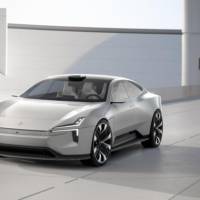Ahead of starting the sales for its first model ever, Polestar is making an entrance with another concept, called Precept. It is a vision of the brand’s future direction and a clear expression of intent. Precept exhibits the execution of new, more sustainable interior materials, the continued development of the digital user interface and the essence of Polestar design.
The name “Precept” was chosen to emphasize the vehicle’s role in setting out Polestar’s intent as the contemporary electric performance brand. A precept is a manifesto of things to come; a declaration.
A 3.1-metre wheelbase which accommodates a large battery pack gives the stunning four-door grand tourer a very low and sleek silhouette with an emphasis on leg- and headroom in the rear.
The front grille is replaced by the Polestar SmartZone, representing a shift from breathing to seeing. An area which once channeled air to radiators and the internal combustion engine, now houses technology for safety sensors and driver assistance functions. Purposefully gathered behind a transparent panel dedicated to intelligent hardware are two radar sensors and a high definition camera. The LIDAR pod, mounted atop the glass roof, is given optimal visibility as a next step towards increased driving assistance. The Thor’s Hammer LED headlight signature evolves with separated elements, taking on a dynamic, more robotic and brand-defining interpretation.
Precept features an integrated front wing above the SmartZone which accelerates air flow over the long bonnet. This allows air to attach itself to the surface earlier, which improves aerodynamic efficiency and thus improves the vehicle’s range. At the rear, the wide light-blade spans the entire width of the car, extending into vertical aero-wings – another aerodynamic feature and a nod to light-weight design.
Conventional side mirrors are replaced by camera-based units, each of which extends outwards on an aerodynamic arm. Inside, the traditional rear-view mirror is replaced with a digital screen, the image collected by a wide-angle camera mounted at the rear of the car. The absence of a conventional rear window means that the Precept’s single-volume glass roof extends behind the rear seats and the tailgate itself is designed with a larger opening and higher-mounted hinges improving access.
Sustainable new interior materials balance modern high-tech luxury with reduced environmental impact. Bcomp’s flax-based composites for interior panels and seatbacks offer significant improvements over conventional materials, including up to 50% saving in weight and up to 80% reduction of plastic waste.
Seat surfaces are 3D-knitted from recycled PET bottles, bolsters and headrests are made from recycled cork vinyl, while carpets are made from reclaimed fishing nets. These elements, combined with digital artistry, define a new premium luxury that surpasses the conventions of leather, wood and chrome.
The next generation HMI, powered by Android, builds on Polestar’s close collaboration with Google. An enlarged, portrait-oriented 15-inch centre touch screen complements a 12.5-inch driver display, and the two are linked by an illuminated blade that encompasses the entire interior. In this execution, the unique Polestar emblem floats holographically inside a solid piece of Swedish crystal between the rear seat headrests.
Polestar will present Precept at the Geneva International Motor Show.
Source: Polestar





